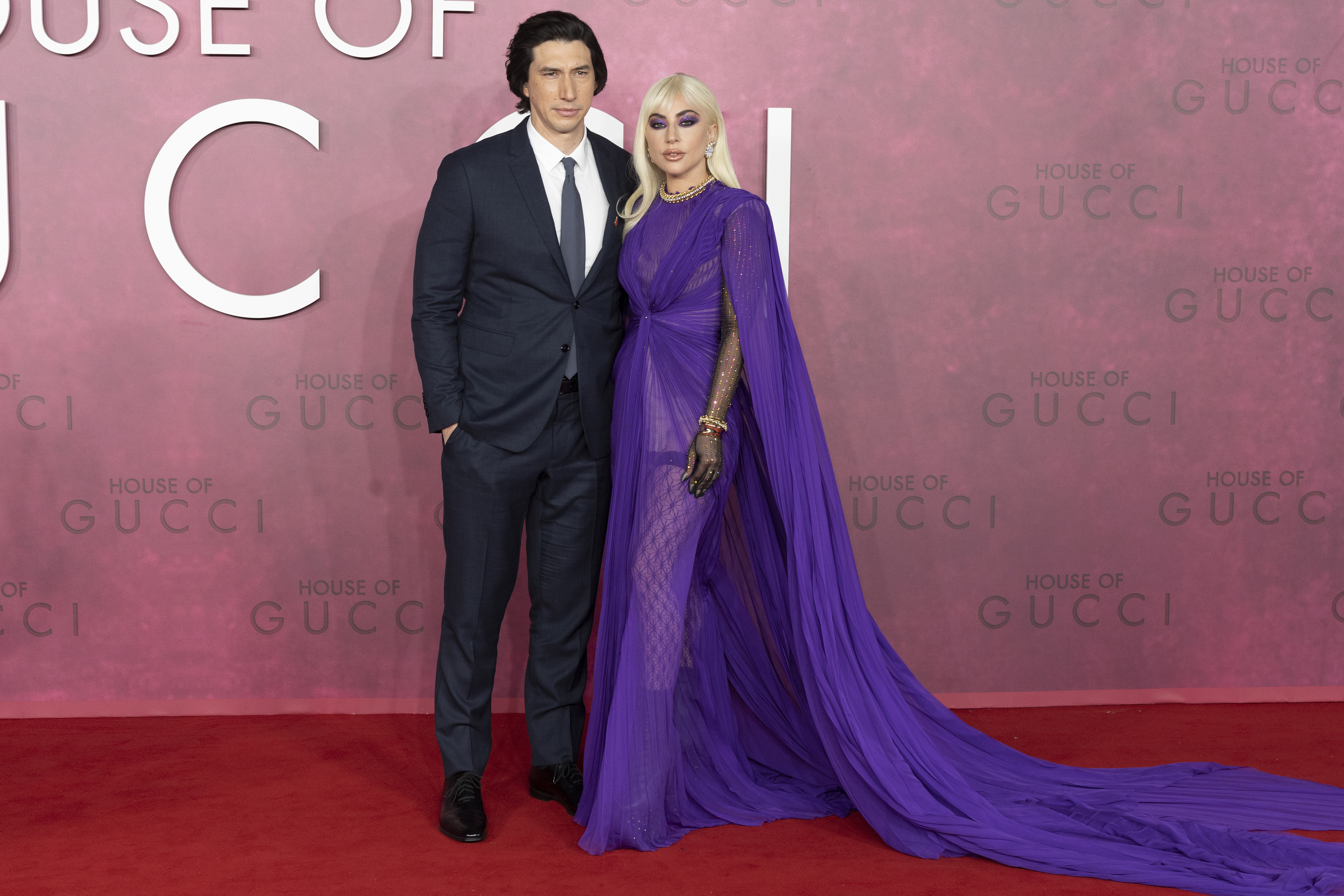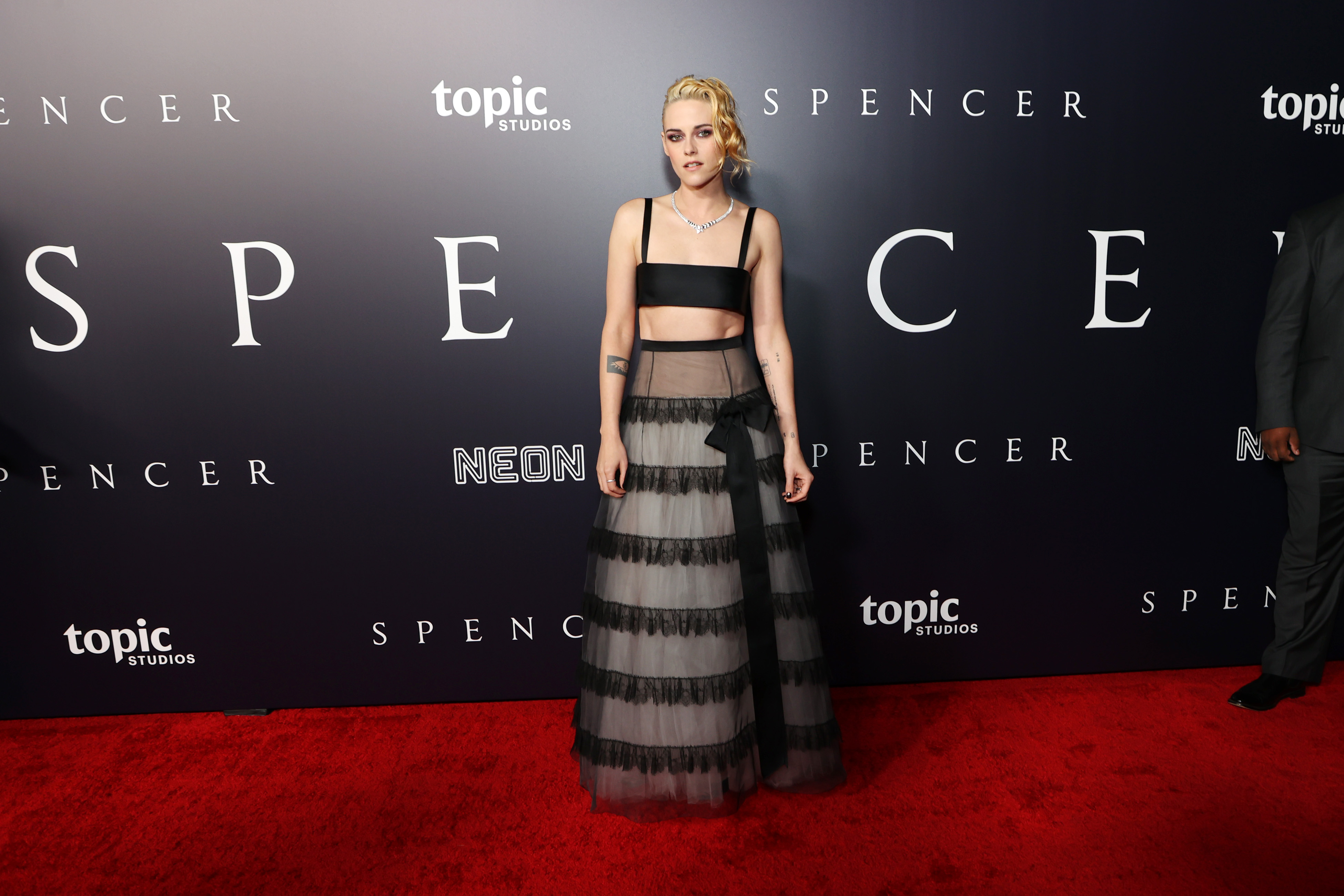

Adam Driver and Lady Gaga attend the UK film premiere of House Of Gucci in London, United Kingdom on November, 09, 2021. (Photo by Stringer/Anadolu Agency via Getty Images)
The other night watching Lady Gaga doing what was demanded of her stardom by daring yet again to stake her claim to another damn red carpet at the London gala premiere of House of Gucci, I oddly and disconcertingly started thinking of Lady Di who never could put down her own stake in the way it was demanded of her in this city. The House of Windsor won that dare it had with her while she lived, but it keeps losing it to her since her death because her presence is no longer a reality for us old enough to remember her complicated saga as she acted it out for us herself but instead has melded into myth for the next generation as actresses – most recently Kristen Stewart in Spencer, Emma Corrin and Elizabeth Debicki in seasons four and five of The Crown and Jeanna de Waal on Broadway in Diana: The Musical which can also be screened on Netflix – portray for them grandly reimagined conceptual aspects of her. Gaga generationally replaced Madonna in the cultural imagination before surpassing her as an actress and, yes, movie star. But Diana generationally replaced Diana. Is there a kind of magic in that or is it just the need for content in the new media age that causes all our consciousnesses to stream together? I choose magic for there is an alchemic quality to all myths and death can deliver these magical ingredients needed for a different kind of majesty. In that, James Dean and Marilyn Monroe are the attendants who had to make room for the appropriately named Prince in Diana’s mythic court. Or maybe this reimagined Diana replacing the real Diana has to do with her having shattered the princess myth itself before she died by embodying it in ways that this new generation looking back on her can relate to since it is not frozen in its fairytale narrative constructs. It will be interesting to see if girls now in the thrall of Frozen, another princess narrative, will ever unfreeze themselves from its icy charms.
Gaga’s own ice the other night – the diamonds that accessorized her daring-do stardom – glistened in the glow of flashbulbs as she raised the wing-like diaphanous cape on her billowing Gucci gown to catch the London breeze as she, her own attendant, purposefully pulled the slit in the gown to one side to display some gartered, elaborately stockinged leg. “Look at her,” I said to my companion because we just couldn’t take our eyes off her. “Drive that truck, honey,” I said in admiration of her working-class attitude about that job she had to do working that carpet. There was a sense of her parking herself before us all and revving the truck’s engine for the enjoyment of all those admiring her newly waxed chassis. There is always a wink Gaga adds to the wonder she can still experience at being the center of attention, and then a steely eyes-front-and-center-unmoving gaze as she heads for the next strategically placed flashbulb awaiting her where she once more winks our way. Stardom relaxes her. It’s those moments in-between where the steeliness is required. I found myself last night wishing Diana had learned to wink in such a way – even to steel herself before we indeed stole her from herself – instead of finding the deadening allure of lowering her eyes in demureness. If only she had had some working-class oomph to go along with her upperclass carriage, she just might have survived. And yet it is because she didn’t survive that she lives more than ever in our reimagined versions of her now.

I had already walked by Jared Leto on the House of Gucci red carpet working the rope line and signing autographs with his nail-polished fingers. There is a real work ethic as well behind Leto’s idea of his stardom, an egalitarianism he’s developed in his other career as a rock star fronting his band, Thirty Second to Mars. Salma Hayek momentarily hijacked the carpet with her husband François Henri Pinault whose company Kering owns Saint Laurent, Alexander McQueen and, yes, Gucci. Adam Driver next ambled into view as Jeremy Irons’s disembodied voice as he was being interviewed on some microphone somewhere was broadcast into Leicester Square where it hovered over it all, the klieg lights and Gaga and Leto having a go at stardom and the billboard-size posters arrogantly seizing the view with their oversized, overwrought glamour depicting the film’s cast costumed as its characters in the clannish, at times clownish way the Guccis are portrayed in the film. Irons’s magnificent mellifluous mumble continued to settle over us as if his own stardom were a lozenge permanently lodged inside his jaw. Still discomfited by my thoughts of Diana at such an event, I found the sound of Irons’s just-Jeremy voice comforting. It wasn’t exactly cutting through the frenzied clamor of the effort it takes to conjure glamour in 2021 but had instead enveloped it all in a velvety nonchalance that true old-school glamour can still glom onto.
Later during the screening of the film after Irons’s last scene as Rudolfo Gucci, Lady Gaga’s own distinctive voice cut through the darkness in the audience from where she sat. “Bravo Jeremy!” she shouted. She was right. He’s the best thing in the film which can veer off into almost opera buffa at times. She’s giving an Oscar worthy performance herself although I can see that some could describe it as the performance that Gina Lollobrigida would have given if she had been cast in the 1980s nighttime soap opera Dynasty in the Joan Collins role. I prefer to think of it as her homage to Anna Magnani. The whole cast is quite good even as their divergent acting styles made me think they all had different ideas of what film they were making.

Gaga’s competition for the Oscar will be Kristen Stewart who portrays Diana in Spencer, the best of the Diana performances that are culturally surrounding us these days. That film is described as a fable based on a real life tragedy and takes place over a bad Christmas holiday spent with the Royal Family when her sons were still children. The fact that this actress was chosen by the film’s director Pablo Larrain speaks to the generational divide in our view of Diana. Stewart captures the essence of the woman – even eerily her voice for those of us who remember it – and yet because of her own public image she modernizes Diana who would have been 60 this year if she had lived.
Kristin Stewart is a lesbian who has announced that she has become engaged to her girlfriend, Dylan Meyer. Emma Corrin, who was also brilliant in her own way as Diana in The Crown, identifies as queer and has stated that her preferred pronouns are “she” and “they.” Not only does this speak to the fluidity of sexuality with which so many in the younger generation are comfortable, but also to the fluidity in the reimagining of Diana herself. There is as seriousness in the tragic aspects of her life depicted in Spencer and The Crown. But there is also room in it all for camp, however unintended, as evidenced by the house parties thrown to watch Diana: The Musical on Netflix and laugh at and sing along with its lyrics. There is even a poetic element to Corrin identifying as “they” since there was so much “they”-ness that plagued Diana’s life – the “they” of the Royal Family, the “they” of Charles and Camilla, the “they” of the paparazzi and tabloid press, the “they” of the ethnicity of her lovers toward the end of her life. There is even now with this plethora of Diana films and television series and even a musical, the “they”-ness of herself. When I was watching the new James Bond film, I kept looking at the young girl who was playing his daughter and wondered if in 20 years she’d be playing Diana in some further reimagining of her and another columnist would be writing about it and wondering why Diana continues to fascinate us so.
Diana’s divorce lawyer Anthony Julius once told Tina Brown, who wrote The Diana Chronicles, “I never saw someone who was as much a project under construction as Diana. You could almost see the plumbing and wires as she was changing in front of you.” Twenty-four years after her death – Kristen Stewart was seven-years-old when Diana died – she keeps changing in front of us. The idea of Diana evolves as the culture evolves. Gaga too in her way keeps evolving mirroring who we need her to be. A Diana of an earlier generation named Trilling wrote, “There’s much to be said for challenging fate instead of ducking behind it.” In that, Gaga and Diana finally share some common ground.
Brown has written a sequel to The Diana Chronicles titled The Palace Papers, Inside the House of Windsor – the Truth and the Turmoil, which will be published in April 2022. She also reimagined Diana for an essay she wrote this year for Tatler, a magazine for which she was once Editor in Chief as she was at Vanity Fair and The New Yorker. This is its last paragraph: “What would the 60-year-old Diana have thought now, watching the Oprah interview [with Harry and Meghan] from David Geffen’s boat in the Caribbean with her third husband? Would she have been happy that her adored Harry had found the love she never had and sought valiantly to protect a wife so miserable that she harboured, as Diana once did, thoughts of suicide? As she might have texted her old friend Elton John with grim flippancy: ‘Been there, done that.’”
That reads like a scene, in fact, in a future film. Maybe Gaga can play her.













